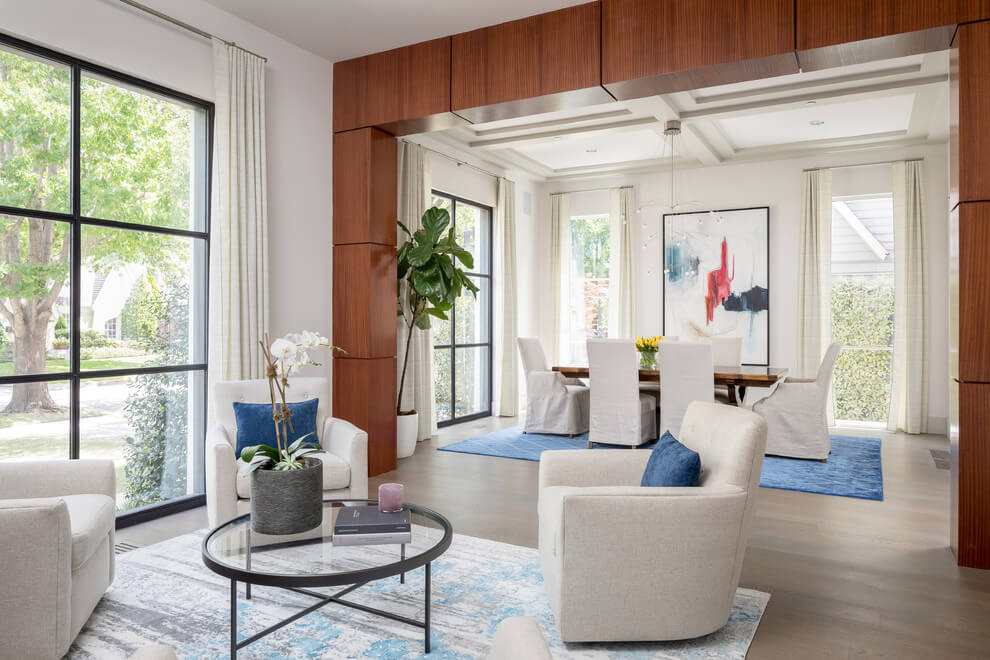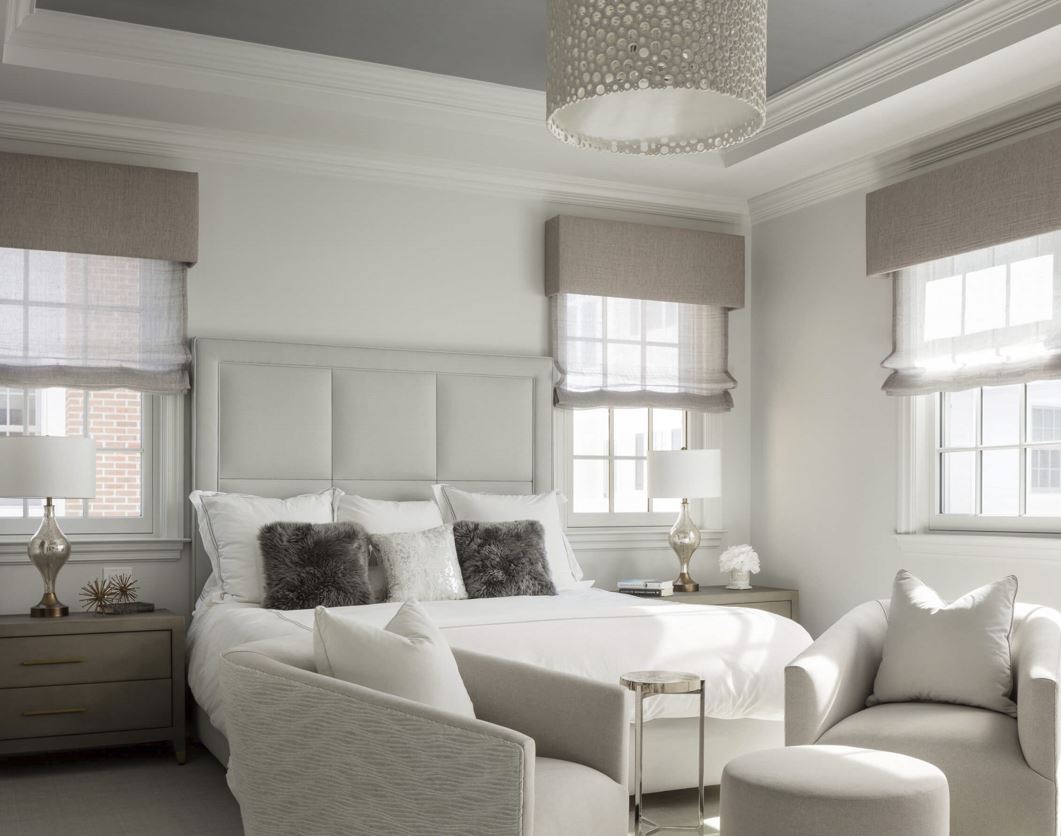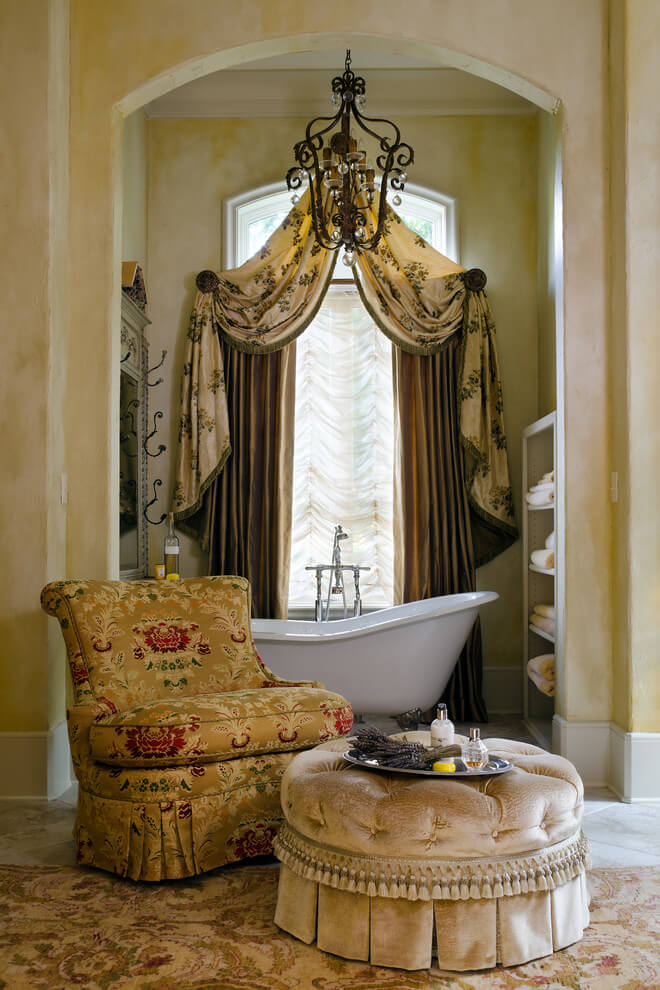When the word “window” is used, many of us imagine a rectangular, standard window and do not quite understand what else to talk about. But modern buildings are distinguished by a very diverse architecture, and, accordingly, the windows in such facilities are very different. This is especially true for the happy owners of cottages when each owner is trying to create something unusual in the face of their house. Thus, there are more and more new types of windows that require a special approach in design.
Without curtains on the windows, the interior looks unfinished. However, the wrong choice of curtains will nullify all the efforts to decorate the rooms. Let’s figure out what the options are, and what each type of window decor is intended for.
Curtain models are divided into two main groups according to the type of control system:
- Sliding (swing) – the traditional way of decorating window and door openings, fabric canvases move to the right and left along the vertical plane of the cornice. Control mechanisms: manual, mechanical, electrical;
- Lifting – due to a unique mechanism, is raised and collected in folds in the upper part. Types of management: mechanics and electrical.
How to choose the type of curtains
If you wish, you can fit any model of curtains into the setting. However, in case of a mistake, it will ruin the impression of the room’s design. Here’s how to make the right choice:
- Assess where the windows face. If to the north, give preference to light translucent curtains. There is already little natural light in the room, and thick curtains will generally block the path of the sun’s rays.
- Choose products based on your interior style. Some models fit into the classical directions and completely different ones into the modern ones.
- Consider the purpose of the room. For example, practical options made of thick fabrics or roller blinds are suitable for the kitchen. For the living room, elegant curtains or original light curtains.
- Choose your color scheme carefully. Focus on the primary colors in the setting. You can prefer curtains of similar colors or play in contrast.
- Be careful with the decor. Luxurious pickups and lambrequins are not always appropriate in the setting.
- Measure the width of the window opening. Heavy curtains will look ridiculous on narrow windows.
Don’t forget about personal preference. If you like certain types of curtains, feel free to look for ways to integrate them into the interior. Don’t forget to learn how to hang your curtains properly.
Long curtains in the interior
Fabrics and materials for curtains
The quality and appearance of curtains depending on the material. More than 30 types of fabrics are used for the manufacture of curtains. We have collected the characteristics of the most common.
| Fabric | Advantages | Disadvantages |
|---|---|---|
| Linen | 1. Resistant to UV radiation. 2. High strength. 3. Simple maintenance. | 1. Crease. 2. The likelihood of shrinkage after washing. |
| Gabardine | 1. Durability. 2. Lack of shrinkage. 3. Ease of care. 4. Waterproof. 5. Breathable surface. | 1. A peculiar texture. 2. Tendency to shedding threads. |
| Velvet | 1. Soft texture. 2. Noise isolation. 3. UV resistance. | 1. Severity. 2. Tendency to accumulate dust. 3. Not compatible with all interior styles. |
| Jacquard | 1. High density. 2. Long service life. 3. Creation of drapery. 4. Ease of care. | 1. The likelihood of thread shedding. 2. Relatively high cost. |
| Atlas | 1. Smooth surface. 2. Moderate density. 3. Strength. 4. Hypoallergenic. 5. Antistatic properties. | 1. Difficulty in leaving. |
| Taffeta | 1. Preservation of the form. 2. Wear resistance. 3. Durability. | 1. Ability to shrink. 2. Crumpling. |
| Mat | 1. Preservation of the form. 2. Interesting texture. 3. High density. | 1. Not compatible with all interior styles. |
| Veil | 1. Delicate texture. 2. Translucency. 3. Ease. | 1. Lack of antistatic properties. 2. Ability to shrink. |
| Organza | 1. Unique texture. 2. Moderate rigidity. 3. Simple maintenance. 4. Resistant to ultraviolet. | 1. Poor breathability. 2. Poor antistatic properties. |
| Reaper | 1. Embossed texture. 2. Simple maintenance. 3. Preservation of the form. | 1. Poor antistatic properties. |
We should also mention the blackout fabric. The material consists of three layers: reflective, retaining light flux, and decorative. Curtains made of such fabric are perfect for a bedroom and a nursery – they can create a twilight in the room for a comfortable stay. There are certain criteria for choosing blackout curtains. It will not be difficult for you to find a model for any interior style.
Bamboo, paper, and wood curtains are trendy now. These are great options for interiors in eco and ethnic styles. The decor looks amazing on the windows and creates a unique ambiance.
Another bold idea is PVC curtains. Such models are suitable for minimalist designs and eclectic trends.
Wooden curtains in the interior
Paper curtains in the interior
Blackout curtains in the interior
Types of lifting curtains
Lifting curtains – curtains designed to be fixed on special curtain rods with manual or mechanical control. They have not been pushed apart like ordinary curtains but raised. However, each model has its characteristics. Consider six types of curtains.
Austrian
Austrian curtains are canvases with lush scalloped folds. Most often, they are made from linen, organza, color, guipure or veil. Both long and short curtains look equally impressive.
Austrian curtains are suitable for the nursery, kitchen, living room, bedroom, balcony. They look attractive on the windows and perfectly protect from the sun’s rays.
French
French curtains have a second name – awnings. These are cascading models of lifting curtains. Outwardly, they are similar to the Austrian ones, and the only difference is in the number and size of shuttlecocks. French curtain canvases are divided into vertical sections of cascading folds. Lush scallops retain their shape even when the curtains are lifted.
French curtains are made from light, expensive fabrics. It is advisable to choose soft flowing materials that will look beautiful—ideal options: chiffon, muslin, organza, veil, silk, cambric. Awnings will perfectly fit into a classic interior. It is a perfect decoration for bedroom and living room windows.
Roman
Roman curtains are dense fabrics without folds. Laconic models for modern interior styles.
- Rotary chain: products that look like blinds. It is easy to control the canvases using a unique shaft.
- Rope: lightweight curtains made of translucent material. Convenient rings are used to attach the curtains to the lifting cornice. To control the web, pull on the cord.
- Combined: double canvases of different materials. They can be held using both rotary mechanisms and cables.
Roman models are suitable for any room, but they are often placed in the kitchen, bathroom, and study. A wide range of colors and excellent performance make these curtains one of the most popular among the entire range of lifting models.
English
English curtains are canvases made of airy fabrics that, when lifted, form beautiful folds. Such models are often complemented with original decor, for example, beads, cords, and tassels.
The lifting mechanisms for English curtains have a self-locking function. This means that can stop the curtains at any height, and the level is fixed. Then next time, you won’t have to regulate anything.
Such models are considered universal – they look great in any room. You can choose them for the living room, nursery, bedroom, study, and kitchen.
Roll
Roller blinds for modern interiors are an intermediate option between curtains and blinds. They are distinguished by their laconic design, absorb sunlight well, do not fade under the influence of ultraviolet radiation.
To manufacture such models, a special dense fabric with an antistatic effect is used, due to which dust practically does not accumulate on the canvases. This property makes curtains indispensable for premises such as a library, balcony, loggia.
Special cornices are provided for the curtains. There are products with manual and remote control on sale. The main thing is to figure out how to fix roller blinds properly.
Pleated
Pleated curtains are fabrics made of dense material gathered in a fold. Unlike Roman, English, and French models, there are no airy scallops on the curtains. But some elements resemble an accordion.
Many are sure that such curtains are only suitable for the office. However, designers are actively using pleats to decorate windows in modern interiors. The products will perfectly fit into the living room, bedroom, study, and kitchen.
Types of sliding curtains
Sliding curtains are the usual and most common design option for window openings. To create the required level of natural light, can move the canvases along the cornice. Let’s study all the varieties of such models.
Classic straight
This is a sliding regular curtain with light tulle curtains. Such models are suitable not only for classic interiors. They will become a worthy attribute of furnishings in the country, pop art, art deco, deco, modern.
Spectacular velvet curtains, models from jacquard, satin, blackout look amazing in the interior. They can be complemented with decor, for example, beautiful pickups or lambrequins. Another interesting option is to lay the curtains in neat folds. This can be done easily with a curtain tape.
Crossed
Curtains are called crossed, the canvases of which are placed crosswise on the cornice. In the lower part, the curtains, on the contrary, are fixed on different sides.
If you do not know how to choose curtains for the bedroom, pay attention to these models. Light flowing curtains provide excellent protection from sunlight and create a romantic atmosphere.
Crossed curtains are suitable for interior styles such as classic, province, country. They will be a godsend for those who want to decorate windows originally.
Cafe curtains
Cafe curtains are light curtains fixed in the middle of the window. Such models are the perfect complement to interiors in the styles of shabby chic, country, Provence. They will look great in the kitchen, on the balcony, in the dining room.
Cafe curtains are made from both light and dense fabrics. Any colors, prints, patterns are acceptable. But it can not use additional decor with such curtains – they look original even without it. The exception is bowed on the cornice. The canvases are remarkably combined with them.
Curtains with Pelmet
Pelmet is a strip of fabric fixed at the top of the curtains. The decorative element is made of satin, chiffon, organza, silk, veil, satin, velour, and other materials with an interesting texture. Sometimes lambrequins are decorated with bows, tassels, rhinestones, patterns.
In addition to rectangular, there are several other types of lambrequins:
- Swag is a semicircular decor with beautiful folds. Elements are overlapped or next to each other.
- Half-wagons are cross-over elements that are placed along the edge of the curtains. The central space must remain free.
- Jabot is a one-sided element with decorative cascading folds. It is placed along the edges of the curtains to enlarge the window opening visually.
- The tie is a lambrequin, similar in shape to a jabot. The difference is in the configuration – it is part of it much larger than the other. The decor is also placed on the sides of the canvases with the long side to the curtains.
- Puffs – lambrequins made of fabric gathered in curly folds. There can be various patterns on the surface: zigzags, triangles, rhombuses, braids. For the manufacture of puffs, dense fabrics with a smooth texture and light shine are used.
Different types of curtains are compatible with lambrequins—for example, classic straight curtains, tulle, pleated curtains. The main thing is to choose a spectacular color scheme. The decor can be the same shade as the curtains or act as a contrasting detail.
Japanese curtains
Japanese light protection systems – panel-type thick curtains. They consist of two canvases that move due to fixed guides installed in the cornice. Products can be decorated in any color scheme, decorated with prints and patterns. There are no folds or other decorative elements on the surface of the canvases. The beauty of Japanese curtains is precisely in the minimalistic design.
If you are looking for curtains for the kitchen or balcony, take a look at them. Also, straight canvases look great on the windows in the office, bedroom, living room. Such models are suitable for interiors in ethno, loft, fusion, Scandinavian, country styles.
Filament curtains
Curtains are made of thin threads of the same or different colors. Such models are chosen mainly for decoration. Lightweight curtains perfectly replace tulle and act as partitions for zoning. They do not cope with the function of protection from sunlight; therefore, they are suitable for rooms with insufficient natural light.
Kisei is made from various synthetic fabrics, silk, and cotton. According to the texture and type of threads, the following types of curtains are distinguished:
- In the form of noodles.
- Spiral.
- Designed for a rain shower.
- Shiny with lurex.
The photo shows the finished projects of interiors with cotton curtains. See how beautiful decorative curtains look.
Photo curtains
In modern interiors, sliding photo curtains are often found. These are dense canvases with realistic drawings. Urban motives, nature, colorful landscapes from the sea coast, animals are prevalent.
Photo curtains perfectly protect from sunlight and save if the view outside the window is unattractive. To mentally find yourself in another reality is enough to look at the curtains and dream.
Now you know what kind of curtains you can decorate your home with. Arm yourself with tips on how to hang curtains on the balcony, kitchen, and other rooms and start the creative process of transforming windows and doorways.




























